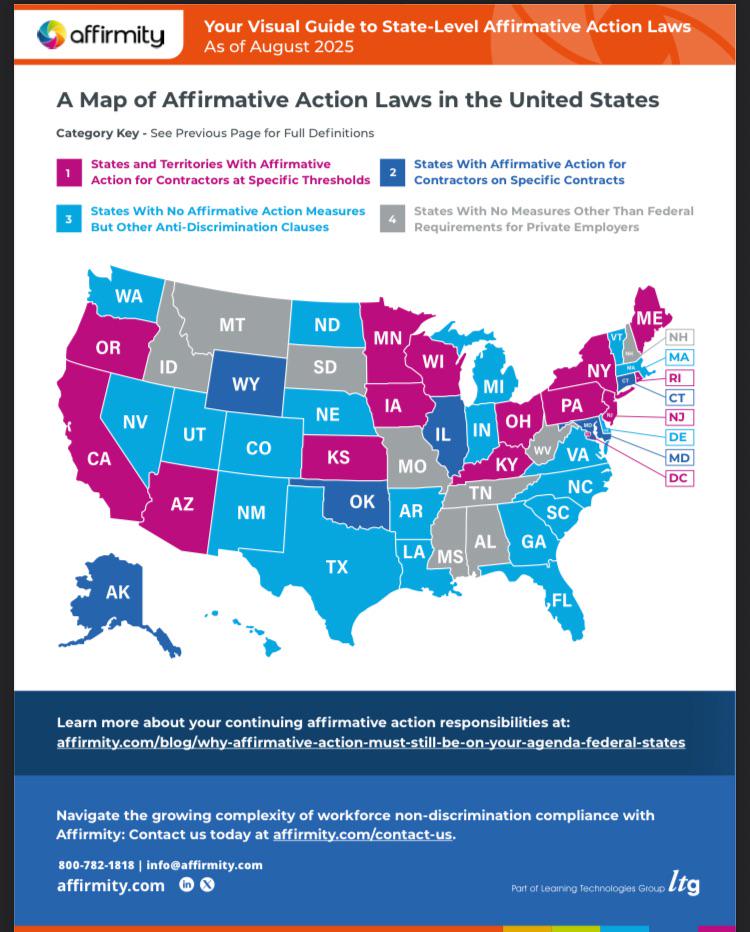State Affirmative Action Laws Map


David Chen
Data Visualization Specialist
David Chen is an expert in transforming complex geographic datasets into compelling visual narratives. He combines his background in computer science ...
Geographic Analysis
What This Map Shows
The "State Affirmative Action Laws Map" provides a comprehensive overview of the current legal landscape regarding affirmative action policies across the United States. This visualization highlights which states have enacted affirmative action laws, which have prohibited them, and those with no clear stance. Understanding this map is crucial because affirmative action plays a significant role in shaping educational and employment opportunities, influencing diversity and inclusion efforts nationwide.
Deep Dive into Affirmative Action Laws
Affirmative action refers to policies that aim to enhance opportunities for historically marginalized groups, particularly in education and employment. These policies can include measures such as recruitment efforts, outreach programs, and the consideration of race or gender in decision-making processes. The roots of affirmative action trace back to the civil rights movements of the 1960s, aiming to address systemic inequalities and discrimination.
Interestingly, the legal framework surrounding affirmative action has evolved significantly over the past few decades. The Supreme Court has ruled on numerous cases that have shaped how these policies are implemented. For instance, landmark decisions like *Regents of the University of California v. Bakke* (1978) and *Grutter v. Bollinger* (2003) have affirmed the constitutionality of considering race in admissions processes, albeit with specific limitations.
However, the landscape is not uniform across the nation. Some states, like California and Michigan, have enacted laws prohibiting the use of affirmative action in public employment and education. This shift often stems from public referendums and changing political climates, reflecting the contentious nature of the debate surrounding affirmative action. States such as New York and Illinois, on the other hand, have maintained affirmative action policies, thus fostering diversity in higher education and employment sectors.
The implications of these variations are profound. For instance, states that have outlawed affirmative action may see a decrease in racial and ethnic diversity within their universities, which can perpetuate cycles of inequality. Furthermore, businesses in these states might face challenges in creating inclusive work environments, impacting their competitiveness in a diverse global market.
Regional Analysis
Examining the map by region reveals stark contrasts in how states approach affirmative action. In the West, for example, California stands out as one of the earliest states to prohibit affirmative action through Proposition 209 in 1996. This decision has had lasting effects on the demographics of its public universities, leading to significant debates over diversity in educational settings.
Conversely, states in the Northeast, like Massachusetts and New Jersey, continue to support affirmative action initiatives, reflecting their historically diverse populations and progressive political leanings. Interestingly, these states often report higher enrollment rates of underrepresented minorities in higher education institutions compared to their counterparts in the West.
In the South, the situation varies widely. States like Texas have implemented affirmative action policies at public universities, largely due to the state's unique demographics and the need for a diverse workforce. However, neighboring states such as Florida have moved towards more restrictive policies, highlighting the localized nature of this issue.
Significance and Impact
The significance of affirmative action laws extends beyond the confines of education and employment; they touch upon broader societal issues of equality, justice, and opportunity. As the U.S. becomes increasingly diverse, the effectiveness and fairness of affirmative action policies remain hotly debated topics. The map not only illustrates where these laws exist but also serves as a reflection of societal values and the ongoing struggle for equity.
Looking ahead, trends indicate that the conversation around affirmative action will continue to evolve. With challenges to existing laws and potential new legislation on the horizon, stakeholders in education and business will need to stay informed and engaged. The map serves as a vital tool for understanding the current state of affirmative action laws, encouraging informed discussions about diversity and inclusion in America.
Have you noticed how these policies can influence not only the demographics of educational institutions but also the workforce of tomorrow? As we move forward, the interplay between state laws and federal guidelines will undoubtedly shape the future of affirmative action in the U.S., making this map a critical reference point for policymakers, educators, and advocates alike.
Visualization Details
- Published
- October 29, 2025
- Views
- 12
Comments
Loading comments...